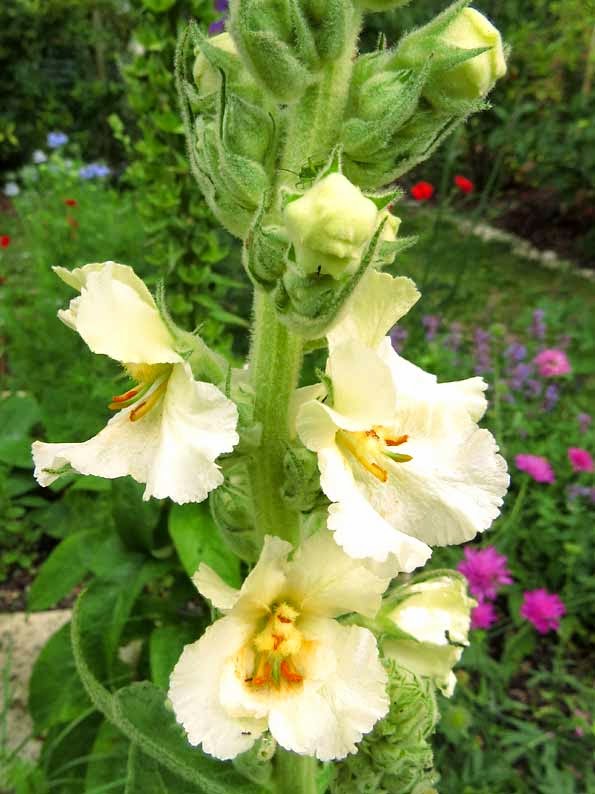"I must have flowers, always, and always" - Claude Monet
 |
| The delicate hues of Rosa versicolour |
 |
| Roses with allium and foxglove - painted by an 'Old Master'? |
Although we'd had some lower branches lopped off our big ash tree last autumn, the weight of leaves was too much for another higher branch which had been thrashing back and forth in the gale.
I heard an ominous cracking noise during one particularly strong gust and ran indoors for car keys in order to move our Peugeot out of the line of fire. Luckily the branch didn't actually break whilst I was underneath but it's a salutary reminder of how brittle our trees can become with age, even after all the rain we've had this year, and it's worth getting them regularly checked by a specialist.
We went to buy some wine from our local vineyard today and asked if the new growth had been damaged by recent turbulent weather, having seen how these winds can rip off young stems. Fortunately their vines seem only to have been affected by the lack of sun and resulting pale growth... we live in hope that there's time for this to be remedied!
 |
| Dianthus gratianopolitanus |
Some types of dianthus make better 'mounds' than others and I particularly like this one which I grew from seed and is supposed to be the original 'Cheddar Pink'. It has delicately fringed, deep pink flowers and is happy growing on dry limestone in full sun.
Now is good time to put pink cuttings in a very gritty compost - if you can actually find some non-flowering stems to use!
Another herb which provides vibrant flowers is a form of small leaved sage, Salvia microphylla, which is also suitable for container planting. There's a popular variety with bi-coloured red and white flowers called 'Hotlips', but we prefer the single shades which are really intense and velvety in texture.
Here in this vase you can see two different kinds of red - one scarlet and one slightly more fuschia. There's also one with creamy flowers and others in shades of blue, purple or salmon pink.
 |
| Toadflax or Linaria purpurea |
In the same vase are some blooms of purple toadflax, an unassuming but neat plant which grows just over a meter tall in semi-shaded areas. It has attractive blue-grey foliage and an upright habit which means it can be useful for flower arrangements.
So far it appears to be fairly drought- tolerant and pest-free - all of which makes it a good garden friend and worth pursuing in seed catalogues to find out if there are other slightly more exciting varieties to be cultivated.
 |
| Larkspur flowering and in bud |
A fine, upstanding type of delphinium is the annual larkspur which has seeded itself around our garden, together with good old love-in-the-mist (Nigella damascena) which has similarly light and feathery foliage.
Whereas Nigellas tend to get too bushy and we end up removing most before they've finished flowering, the larkspurs form more open, branching plants which look quite stately in the border, particularly those with dark mauve blooms. White and pink varieties are often sold in a mixed packet of seeds but these colours don't seem to come back as readily as the mauve which just goes on seeding itself in sunnier areas.
 |
| Salvia sclarea var. turkestanica |
Many sages are surprisingly scented, including some of the microphyllas mentioned above which smell of blackcurrants. It's certainly a good reason for growing lots of different salvias in your garden and most of them are more ornamental than culinary, with quite a long flowering period.
 |
| Verbascum hybridum "Snow Queen" |
The first of these began opening its flowers last week, having reached a height of about 120cm, unlike the wild yellow ones we see which can be well in excess of two meters and rarely manage to stay upright. I'm glad to say that its leaves, too, are fairly restrained and don't take up too much space. Hoverflies seem to love them and the bundles of pollen remind me of miniature Easter chicks...!
On a more prosaic note, we spent an afternoon turning our compost recently as it's probably not been done for six months and we were in need of some rotted material to use as mulch. We have a home-made bin under the ash tree into which we put our fruit & veg bits as well as most of our garden waste, all carefully cut up so that it rots down more easily.
If we had lawn clippings, the heap would warm up and make compost quite rapidly; but with a large amount of woody offcuts, it needs to be kept moist and turned at least once a year. Once it's started to become dark and crumbly underneath, we dig out the bottom layer and put it in a plastic compost bin with a lid to finish off the process.
Close to the compost area, we came across this young tree frog relaxing on the leafy branch of a Cotinus bush. Not exactly the best form of camouflage you might think, but then again he can squirt out a noxious liquid if attacked by a predator - as our cat has discovered in the past!
 |
| Reinette resting on a smoke bush |


No comments:
Post a Comment